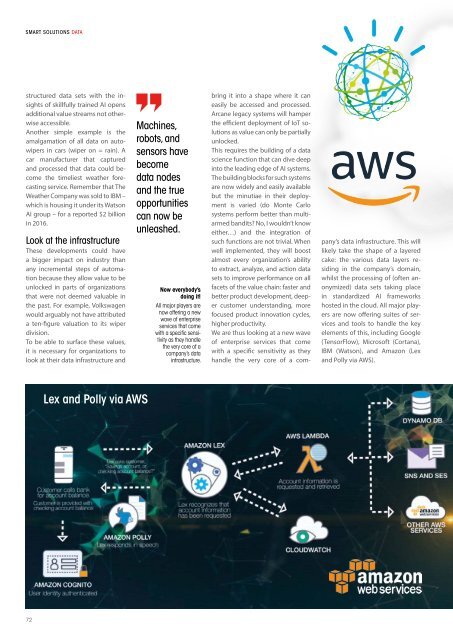Smart Industry 2/2018
Smart Industry 2/2018 - The IoT Business Magazine - powered by Avnet Silica
Smart Industry 2/2018 - The IoT Business Magazine - powered by Avnet Silica
You also want an ePaper? Increase the reach of your titles
YUMPU automatically turns print PDFs into web optimized ePapers that Google loves.
<strong>Smart</strong> Solutions Data<br />
structured data sets with the insights<br />
of skillfully trained AI opens<br />
additional value streams not otherwise<br />
accessible.<br />
Another simple example is the<br />
amalgamation of all data on autowipers<br />
in cars (wiper on = rain). A<br />
car manufacturer that captured<br />
and processed that data could become<br />
the timeliest weather forecasting<br />
service. Remember that The<br />
Weather Company was sold to IBM –<br />
which is housing it under its Watson<br />
AI group – for a reported $2 billion<br />
in 2016.<br />
Look at the infrastructure<br />
These developments could have<br />
a bigger impact on industry than<br />
any incremental steps of automation<br />
because they allow value to be<br />
unlocked in parts of organizations<br />
that were not deemed valuable in<br />
the past. For example, Volkswagen<br />
would arguably not have attributed<br />
a ten-figure valuation to its wiper<br />
division.<br />
To be able to surface these values,<br />
it is necessary for organizations to<br />
look at their data infrastructure and<br />
Machines,<br />
robots, and<br />
sensors have<br />
become<br />
data nodes<br />
and the true<br />
opportunities<br />
can now be<br />
unleashed.<br />
Now everybody’s<br />
doing it!<br />
All major players are<br />
now offering a new<br />
wave of enterprise<br />
services that come<br />
with a specific sensitivity<br />
as they handle<br />
the very core of a<br />
company’s data<br />
infrastructure.<br />
bring it into a shape where it can<br />
easily be accessed and processed.<br />
Arcane legacy systems will hamper<br />
the efficient deployment of IoT solutions<br />
as value can only be partially<br />
unlocked.<br />
This requires the building of a data<br />
science function that can dive deep<br />
into the leading edge of AI systems.<br />
The building blocks for such systems<br />
are now widely and easily available<br />
but the minutiae in their deployment<br />
is varied (do Monte Carlo<br />
systems perform better than multiarmed<br />
bandits? No, I wouldn’t know<br />
either…) and the integration of<br />
such functions are not trivial. When<br />
well implemented, they will boost<br />
almost every organization’s ability<br />
to extract, analyze, and action data<br />
sets to improve performance on all<br />
facets of the value chain: faster and<br />
better product development, deeper<br />
customer understanding, more<br />
focused product innovation cycles,<br />
higher productivity.<br />
We are thus looking at a new wave<br />
of enterprise services that come<br />
with a specific sensitivity as they<br />
handle the very core of a company’s<br />
data infrastructure. This will<br />
likely take the shape of a layered<br />
cake: the various data layers residing<br />
in the company’s domain,<br />
whilst the processing of (often anonymized)<br />
data sets taking place<br />
in standardized AI frameworks<br />
hosted in the cloud. All major players<br />
are now offering suites of services<br />
and tools to handle the key<br />
elements of this, including Google<br />
(TensorFlow), Microsoft (Cortana),<br />
IBM (Watson), and Amazon (Lex<br />
and Polly via AWS).<br />
Lex and Polly via AWS<br />
72
















